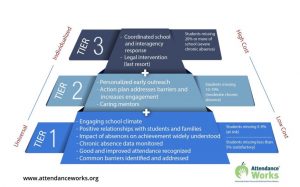Educators have long used multi-tiered approaches to improve achievement and manage student behavior. Attendance Works’ three-tiered framework is being successfully used in schools across the U.S. to improve student attendance. What exactly is the three-tiered framework and how can educators use it to boost student attendance? 
In a nutshell, Tier 1 represents universal strategies to encourage good attendance for all students. Tier 2 provides early intervention for students who need more support to avoid chronic absence. Tier 3 offers intensive support for students facing the greatest challenges to getting to school.
Listen to Attendance Works Executive Director Hedy Chang describe the three-tiered intervention approach in an interview with Valley Public Radio, FM89.
Exploring the three tiers
Tier 1 is the foundation of the support system and includes universal strategies to encourage good attendance for all students. In fact, any attendance effort should begin with tier one strategies. Designed to reach every school student and family, tier one activities are prevention oriented, and include positive messaging, handouts for families and creating a welcoming school climate that engages students and families. When implemented throughout the school year, tier one creates a culture of attendance at school that especially helps at risk (missing 5-9%) students who are on the verge of chronic absence avoid it.
In some schools, tier one interventions include creating a school-wide program to address a common barrier that affects many students. Conversations with families and students or analyzing a school’s data for attendance patterns often show common barriers, such as food insecurity, unsafe or unreliable transportation to school, or missing too many days during the flu season. Approaches such as having free breakfast in the classroom increase attendance and can make it easier for hungry kids to concentrate when they are present. A school-wide immunization program can ensure more kids avoid missing school due to the flu
Tier 2 is for students and families who need more encouragement and support and are most successful when tier one is in place. These interventions target students who have moderate chronic absence (missing 10% to 19%) and when implemented with fidelity, can go a long way towards reducing a school’s chronic absence rate.
Students and their families who need Tier 2 supports benefit from personalized attention to motivate showing up even when it isn’t easy. They may feel more comfortable sharing information about the barriers they face and be more willing to problem-solve with school staff so a plan can be put in place. For example, if a student is avoiding school because of bullying or academic struggles, educators can take steps to improve school climate or work with a family to devise a plan such as a study group with other students or teachers to provide academic support. Tier 2 supports can and should include solutions for groups of students. If a student has unmanaged diabetes or other chronic health condition, a personalized approach can connect the family to the school nurse or direct them to local health resources. Success mentors can develop trusting relationships between students and caring adults at school.
Reenergizing interventions at mid-year
At mid-year, students with moderate chronic absence can be turned around if a plan is implemented to both address attendance barriers and provide academic support so the student can catch up. At the start of the school year, use data from the previous school year to discover students who have a history of chronic absence, and develop a strategy for more personalized, Tier 2 interventions.
Tier 3 offers individual interventions and wrap around supports from a district’s student support division, public agencies and the courts. Tier three approaches are critical for our most vulnerable students who face serious hurdles to getting to school and may be homeless, involved in foster care or in the juvenile justice system. Don’t miss the opportunity to use lessons learned from working with families and students in tier three (missing 20% or more of school) to inform what needs to be in place at tier one and two to ensure every student feels welcome and receives support as early as possible.
Everyone should keep in mind that students falling into tier three may require multiple years of support to move out of chronic absence given the nature of the challenges that they face. Progress for these students may need to be measured by reductions in total absences in addition to whether they move out of chronic absenteeism.
What type of strategy is best for each tier?
The three tiered pyramid graphic shows the levels and key actions educators can take at each tier. Use your chronic absence data to help see how many kids need additional supports at each tier. Once the data is analyzed, try to understand what is going on with students who are missing school, using this worksheet: Understanding the root causes for student absenteeism. Another worksheet describes interventions that work for each tier. Download a worksheet with interventions or a blank one and tailor it with approaches that fit your school and community circumstances.
Our website offers downloadable resources to develop interventions for all three tiers. The Attendance Playbook, co-developed with FutureEd, provides strategies for each tier, and includes the research backing up some of the interventions.
Need further help starting or expanding a program to address chronic absence? Attendance Works offers fee-based consulting services tailored to individual state agencies, school districts and schools, in addition to free resources and strategies. Find out more about our consulting services.